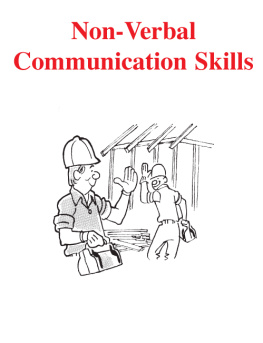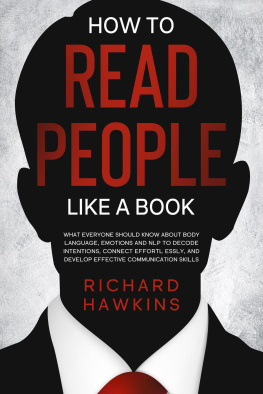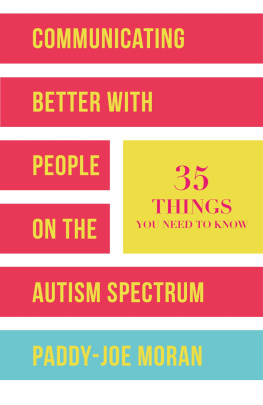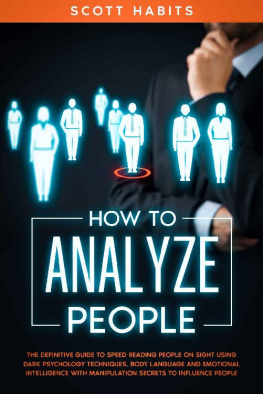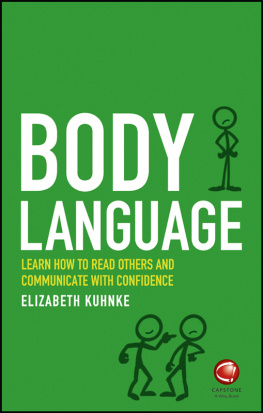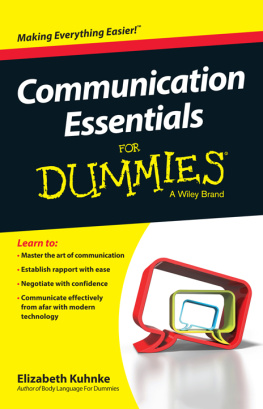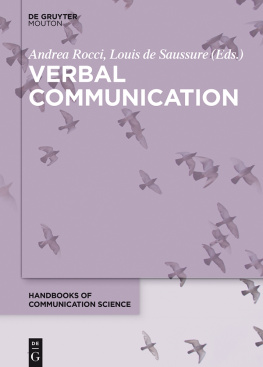Phillip Roy - Non-verbal Communication Skills
Here you can read online Phillip Roy - Non-verbal Communication Skills full text of the book (entire story) in english for free. Download pdf and epub, get meaning, cover and reviews about this ebook. year: 2013, publisher: Phillip Roy, Inc., genre: Religion. Description of the work, (preface) as well as reviews are available. Best literature library LitArk.com created for fans of good reading and offers a wide selection of genres:
Romance novel
Science fiction
Adventure
Detective
Science
History
Home and family
Prose
Art
Politics
Computer
Non-fiction
Religion
Business
Children
Humor
Choose a favorite category and find really read worthwhile books. Enjoy immersion in the world of imagination, feel the emotions of the characters or learn something new for yourself, make an fascinating discovery.
- Book:Non-verbal Communication Skills
- Author:
- Publisher:Phillip Roy, Inc.
- Genre:
- Year:2013
- Rating:5 / 5
- Favourites:Add to favourites
- Your mark:
- 100
- 1
- 2
- 3
- 4
- 5
Non-verbal Communication Skills: summary, description and annotation
We offer to read an annotation, description, summary or preface (depends on what the author of the book "Non-verbal Communication Skills" wrote himself). If you haven't found the necessary information about the book — write in the comments, we will try to find it.
How you say something is equally if not more so important than what you actually say. In Non-Verbal Communication, learn how to read what others really mean while theyre talking and also how to ensure that what youre communicating verbally matches what youre saying with your body language.
Non-verbal Communication Skills — read online for free the complete book (whole text) full work
Below is the text of the book, divided by pages. System saving the place of the last page read, allows you to conveniently read the book "Non-verbal Communication Skills" online for free, without having to search again every time where you left off. Put a bookmark, and you can go to the page where you finished reading at any time.
Font size:
Interval:
Bookmark:
For additional educational curriculum published by Phillip Roy, Inc. please visit: www.philliproy.com
Copyright Phillip Roy, Inc. All rights reserved No part of this book may be reproduced or transmitted in any form or by any means, electronic or mechanical, including photocopying, recording, or by any information storage and retrieval system, without permission in writing from the publisher.
For information address: Phillip Roy, Inc., 13064 Indian Rocks Roads, Largo, FL 33774
Non-Verbal Communication Skills eBook ISBN# 1-56818-365-8
Copyright Phillip Roy, Inc. 13064 Indian Rocks Road Largo, FL 33774 Phone: 800-255-9085 or 727-593-2700 Fax: 877-595-2685 or 727-595-2685 E-mail: info@philliproy.com Web Page: www.philliproy.com
Topic 2 Show the correct signals, gestures, or movements to get someones attention.
Topic 3 Tell what happens when you use signals, gestures, or movements (non-verbal cues) correctly.
Topic 4 Tell what can happen when people do not understand non-verbal cues.
Topic 5 Tell how to use non-verbal cues correctly.
Topic 5 Tell how to use non-verbal cues correctly.
TOPIC 1: Using appropriate eye contact
Activities: Eye contact is looking at the person you are talking to or who is talking to you. When you are speaking and use appropriate eye contact, you are telling the person you want to talk with him or her. When you are listening and use appropriate eye contact, you are letting the person talking to you know that you are interested in what he or she has to say. Select a partner. Sit with your backs towards each other. Take turns talking about one of the best times of your life.
After two minutes, face each other and discuss what it was like talking without looking at each other. Discuss why looking at each other makes it easier to talk. In groups of three, make believe you are going on a job interview. Each of you take a turn being the applicant, the employer, and the observer. The observer should watch the eye contact between the applicant and the employer and the effect it has on the interview. After all three of you have had a turn being each one of the characters, tell what it was like.
Discuss how eye contact helped the communication between the applicant and employer. Assignments: Describe how eye contact can help you when you are talking with a friend. Describe how eye contact can help you when you are talking to a supervisor. Describe how eye contact can help you when you are talking to your child or a child of a friend/relative. TOPIC 2: Using signals, gestures, or movements to get someone's attention
Activities: There are many ways to get someones attention without using words. You can use signals, gestures, or movements.
These are all called non-verbal cues. Some ways are correct and others are not correct. The following give correct and incorrect ways to get someones attention. Discuss the different ways. A. You do not understand the work assignment.
Incorrect: Slam your hand on your desk or table Correct: Ask your supervisor for help B. You see your boyfriend or girlfriend walking with someone who likes him or her. Incorrect: Bump into them. Correct: Wink your eye at your friend. Give 5 ways that you have used signals, gestures, or movements (non-verbal cues) to get someone elses attention. 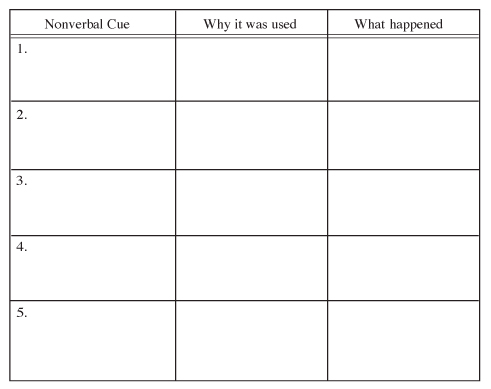
Assignments: Complete the following sentences by writing in signals, gestures, or movements you might use. 
Assignments: Complete the following sentences by writing in signals, gestures, or movements you might use.
Think about then and now. Yesterday, my supervisor criticized me at work and I ___________________ut today I would _________________. Yesterday, I wanted my supervisor to help me and I ________________ but today I would _________________________________. Discuss the correct signals, gestures, movements to use in the following: A. You want your friend to meet the new employee at work. B.
Your favorite basketball player just fouled out of the game. C. You want a supervisor to help you with a work assignment. D. You want to ask a friend to dance with you. E.
You just dropped your hamburger. TOPIC 3: Using signals, gestures or movements (non-verbal cues) correctly
Activities: When you use signals, gestures, and movements, you are helping people to understand you without using words. Athletes use signals during games to give information on plays. A man puts his hand to his ear to let someone know he's having a hard time hearing the person. A boy arguing with another boy turns and walks away to let him know he doesn't want to argue anymore. Signals, gestures, and movements are non-verbal communications.
Look at the following signals, gestures, or movements and discuss when you would use them: A. Smile B. Headshake C. Nod When you use these signals, gestures, or movements, they need to be the correct ones for where you are and for what is happening.
Discuss the following and what happened when the cues were used correctly. A.
Your friend is singing in a spring concert. Nonverbal cue: You smile at her. What happened: She continues to sing well. B. A customer is explaining a problem with a product he or she is returning. Nonverbal cue: You nod and shake your head.
What happened: Your customer sees that you understand the problem and are paying attention. C. Your friend is showing you how to work the DVD. Nonverbal cue: You put your hand on your chin and move closer. What happened: Your friend sees that you are interested and want to learn how to work the system.
Assignments: Describe two non-verbal cues and what feelings they give.
In the sentences above (Activity 2), give different non-verbal cues that could have been used and what you think could have happened. TOPIC 4: When people do not understand non-verbal cues
Activities: When people use non-verbal cues, other people may not understand them correctly. For example: A man touches a womans arm while they are talking. The man wants to make sure the woman is listening to him. The woman thinks the man is getting too friendly and may stop talking to him. You call your mother and she starts crying.
You think she is upset, but she tells you she just heard her brother is getting married and she is crying because she's so happy for her brother. Describe times when a non-verbal cue could be used but someone might misunderstand why the cue was being used. Describe what could happen. On the chart below, give 5 examples of a non-verbal cue and why it was used. Tell how someone might not understand the non-verbal cue. 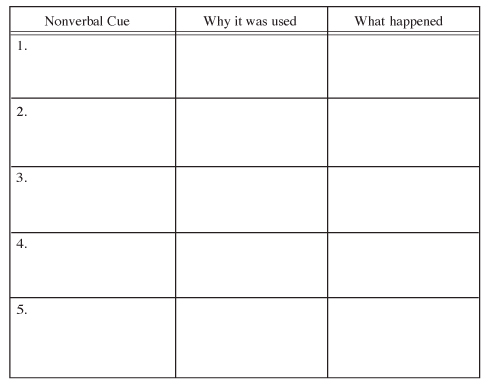
Assignments: Re-read the stories in Activity 1.
Give other ways the non-verbal cues could have been understood. Describe non-verbal cues you often use to get the attention of your friends. TOPIC 5: How to use non-verbal cues correctly
Activities: It is important to use gestures, signals, and movements (non-verbal cues) correctly. When you talk, you also are saying something with your movements. Even when you are not talking, you could be saying something with your movements. A. A.
Appearance: Sloppy, neat, disorganized B. Posture: Relaxed, tense C. Location: Close to someone, touching someone D. Gestures: Moving your hands up and down, nodding your head, pointing, moving your legs up and down E. Eye Contact: Looking into someones eyes, looking around the room, looking down at the floor F. Facial Expression: Smiling, glaring, sad Discuss how you use different non-verbal cues at different times and with different people.
Next pageFont size:
Interval:
Bookmark:
Similar books «Non-verbal Communication Skills»
Look at similar books to Non-verbal Communication Skills. We have selected literature similar in name and meaning in the hope of providing readers with more options to find new, interesting, not yet read works.
Discussion, reviews of the book Non-verbal Communication Skills and just readers' own opinions. Leave your comments, write what you think about the work, its meaning or the main characters. Specify what exactly you liked and what you didn't like, and why you think so.

